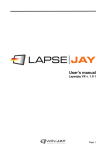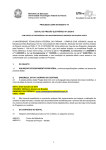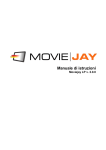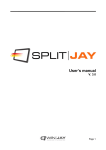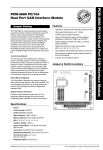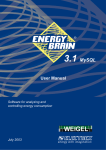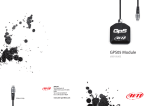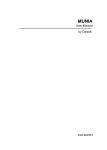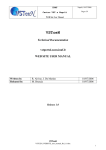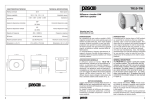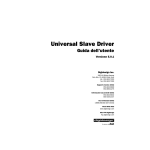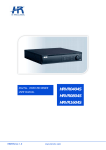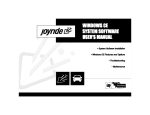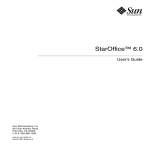Download User`s manual - Winjay S.r.l.
Transcript
User’s manual
Logjay V. 2.0.0
Table of contents
Chapter 1: About Logjay .................................................................................................3
1.1 The non-stop audio logger ....................................................................................4
1.2 The scheduled recorder ........................................................................................5
1.3 The blank detector and the alarm system .............................................................6
1.4 Quickstart..............................................................................................................7
Chapter 2: The recording module .................................................................................11
2.1 Recording profiles ...............................................................................................12
2.2 Scheduling your recordings ................................................................................17
2.3 Default settings ...................................................................................................22
Chapter 3: The player module ......................................................................................25
Appendix: .....................................................................................................................27
Choosing the ACM codec .........................................................................................27
End user licence agreement .....................................................................................29
Page 2
Chapter 1
About Logjay
Originally conceived as an advanced non-stop audio logger, Logjay has been improved
into a comprehensive application which now includes three products in a unique software
package:
•
•
•
No-stop long-time logger to provide your local Radio Authority with copies of
sections of your broadcast on request.
100% customizable recorder with full trigger support, for automatic recording of
satellite news feeds.
Silence detector which tirelessly monitors your radio station output and, in case a
blank occurs, automatically switches an auxiliary audio source while at the same
time notifies your tech personnel by means of fast and cheap SMS messages.
Logjay has been carefully engineered on building blocks, so you may purchase just the
needed channels and features and save money on your initial purchase; for example, you
may purchase only 2 of the 4 available modules, the first one with just the basic features
for the logging purposes, the second one with the "pro pack" which includes the most
advanced scheduling and blank detection features. Of course, you may upgrade to 3 or 4
channels and/or add the "pro pack" for each channel as soon as the need arise.
It is possibile to add an unlimited number of recording profiles: this way, you may program
and schedule recording settings for each recording channel depending on the specific
needs, from recording quality to the storage folder, enabling and programming the blank
detector and numbers where to send your SMS, and so on.
You don't need any "special" or expensive hardware component to run Logjay: the
software works fine with almost any PC equipped with Windows compatible sound cards
(such as the one integrated into your motherboard). Accessing any of the software
features turns very easy for everybody thanks to the Windows XP based interface.
Page 3
Chapter 1.1
The non-stop audio logger
An advanced "last 90" (or 30, or 42, or whatever you wish) days non-stop audio logging
software that takes advantage of today’s PCs digital technology to store massive amounts
of audio with fast access and retrieving features. You can finally get rid of those old reel-toreel logging machines, time lapse video recorders or DATs of questionable quality and
reliaibility, and with high maintainance costs (you have to periodically check machines,
other than purchasing and periodically replace tapes).
Logjay can be set to automatically rotate logged files to keep track of a desider number of
days and if you wish, can automatically erase older days to make room for the new ones.
Recorded audio is automatically indexed by date and time. You can record in mono or
stereo, choose recording quality depending on your needs and available hard disk space.
Logjay offers and instant access to recorded audio thanks to its exclusive indexing and
locating system. Gone are the days of rewinding through miles of tapes for hours (or days)
only to locate the desired passage! With Logjay you just select desidered date and time,
and press play to listen to the exact passage.
More than one copy of the player module can access to the same recordings across a
local network, while recorder module simultaneously carries on recording. You don't need
to stop recording if you wish to listen any previously recorded passage!
Key features:
• Automatically indexes recorded audio by record date and time
• Recorded audio can be played instantly.
• Automatic erases oldest files.
• Freely choose your audio codec: variable quality vs. hard disk space configuration.
Logjay: more power and versatility at a fraction of the cost of a conventional tape based
logging system!
Page 4
Chapter 1.2
The scheduled recorder
Logjay features powerful scheduling features, which allow to automatically start and stop
recording according to a preset schedule for each day of the week or by means of external
triggering from a satellite receiver: this way, tasks like capturing satellite news feeds or
activating recording just when needed are easily performed, saving valuable hard disk
space. At the same time, you may easily schedule recall of your favourite recording
settings (profiles), to change recording quality or any other operating switches.
To access these extra features, you don't need any customized relay cards or other nasty
stuff: just hook the start/stop and audio outputs from your satellite receiver to your sound
card joystick port and line in jack: Logjay works in background and automatically
starts/stops recording as soon the triggers are received marking beginning and end of the
news.
You can record in mono or stereo, choose recording quality depending on your needs and
available hard disk space.
Logged audio can be indexed as date/time (for example, should you wish to edit the
captured news before scheduling) or always use the same file name, which will be
overwritten on each new recording: this way, the on-air scheduling becomes a fullyautomated task: our automation software Winjay just reads the same news file, which is
simply kept updated!
Key features:
• Automatically indexes recorded audio by record date and time
• Recorded audio can be played instantly.
• External triggering via the joystick port, without any costly relay card.
• Freely choose your audio codec: variable quality vs. hard disk space configuration.
Page 5
Chapter 1.3
The blank detector and the alarm system
Monitoring a radio station for constant audio output is at the same time a quite costly task
but indeed of vital importance, especially if you own different trasmission sites on different
frequencies; likewise, it turns surely useful to check for crashes of your radio automation
software, which could leave your radio blanked for hours until somebody realizes that a
fault has arised.
Thanks to its powerful silence detector, Logjay can tirelessly monitor your radio station
output and behave as desired whenever the audio signal goes blank. Of course, the time
before silence is reported as well as the silence threshold are both customizable, so you
won't end up with false reports during orchestral pauses or speech, for example.
As soon as a blank is detected for each of the 4 available inputs, Logjay is able to
undertake two different approaches, which may be used at the same time as well:
•
Triggering a bit on the parallel port to switch an auxiliary audio source or try to reset
your automation system
•
Notifying your tech personnel by means of fast and cheap SMS messages: this way, it
is possible to fix the failure with minimal delay from the detection, without having to
continuosly monitor your signal.
Audio logging and monitoring run at the same time for each channel, so you may listen for
blanks while at the same time logging the incoming audio.
Page 6
Quickstart
Here is a short summary of basic operations for speeding up Logjay initial setup. For
further details we strongly suggest you to carefully read the user’s manual!
Installing your customized parallel port dongle: Turn off your PC, and insert the
supplied hardware key in one of the available parallel (printer) ports. The label engraved
on the key should face your PC chassis. Should you need to connect a printer, plug the
cable to the opposite (free) side of the key, which will be between your PC and printer. Do
not insert the hardware key in the serial interface connector (D-type 25 pins male) since
the presence of negative tensions can alter or damage the contents of the key! This should
not be an issue with the most recent hardware since serial interfaces use a 9 pins male
connector.
If your system is running Windows2000 or XP, you should also install the parallel dongle
driver: just run once the “skeyadd” file found in the “\drivers\winNT-2000-XP_lpt” folder in
the installation CD.
Recording workstation:
1. Insert the installation CD in your CD-ROM drive.
2. Double click on the setup.exe file in the “logjay” folder to start Logjay setup: supposing
that your CD-ROM drive is identified as “D:”, click on “Start”, choose “Run”, type in the
edit box “d:\logjay\setup.exe” (without quotations) and click OK, or simply browse for
the desired file from “my computer” icon.
3. Follow the on-screen guided instructions which will guide you for the rest of the setup
process, then restart your PC.
4. Copy the wjlogo.bmp file from the main folder of your installation CD to Winjay
installation folder (usually c:\program files\logjay if you choose the default one). This file
is your station logo which is needed for software customization.
5. Click on “Start”, “Logjay”, “Logjay recording module” to run Logjay, the main window
should appear in a matter of seconds.
Networked player workstations:
Follow items 1-4 for the recording workstation setup, then:
1. Start Logjay Player, then open its setup window: you’ll have to edit the database path
where the player module should search for informations concerning the logged audio:
just browse for the path to the database on the recording workstation (for example
\\logger\c\progam files\logjay).
2. When setting the storage path in the recording module, change any local path with the
corresponding network path (for example \\LOGGER\C instead of C:\).
3. Remember to share drives on the recording workstation with full read/write access!
Page 7
Quickstart
Once you’re done with setup and initial testing, we strongly suggest you to fine tune your
system setup for best performance:
• Disable screen savers and power saving modes: from the Windows desktop, click the
mouse right button, select “properties”, click on “screen saver” tab, and from the dropdown menu select “none”. In the “Screen power saving setup” section, click on “setting”
and from the drop down menus “turn down monitor” and “disable hard disks” select
“Never”.
• Add Logjay recording module to Windows autostart group, so the software will
automatically restart after a power failure.
• In your PC BIOS setup screen, set the “AC Power Loss Restart” (or similar) feature so
that your PC turns on again automatically after a power failure.
Page 8
Chapter 2
The recording module
Here is a screen shot of Logjay recording module, which performs audio logging and
signal monitor features. This is the main window, which appears when the recording
module is started; it is made of 5 sections: the first 4 correspond to each recording and
audio monitoring channels, the last one includes misc features and indications. Of course,
details may slightly differ depending on your setup and/or enabled channel and features.
Page 9
Chapter 2
Detailed description :
•
Record buttons
Click the Record button corresponding to the desired channel to manually start
audio recording.
•
Stop buttons
Click the Stop button corresponding to the desired channel to manually stop
recording.
•
Spectrum analyzer
For each recording channel, the spectrum analyzers show in
real-time the spectrum of the input audio (audio level at
different frequencies depending on recording sampling rate).
Left-clicking on the analyzer, the exact frequency corrsponding
to each bar will be shown. The analyzer also features a peakhold feature: the peak level segments are temporarily left
visible before resetting themselves. When recording in stereo, the signal shown is the sum
of Left + Right channels. Just below the spectrum analyzer, you’ll see the channel name
as set in the related settings page.
•
VU-meter
For each recording channel, VU-meters
show in real-time the input audio level.
Signal is represented as peak level in dBs,
where the 0 dB is the absolute maximum before a clipping occurs: in this latter case the
“Clip” indicators on the right of each bar will lit. The VU-meters also include a peak-hold
feature: the peak level segments are temporarily left visible before resetting themselves.
When recording in stereo, the upper meter shows level for Left channel, the lower one the
level for the Right channel.
•
Recording settings display
On the left of the spectrum analyzer you will find details
about the selected ACM driver and audio card for each
recording channel. Logjay implements a full support for
Microsoft ACM (Audio Compression Manager) that comes with Windows. Thus, you may
so choose your favourite codec according to your needs (quality vs. hard disk space) as
well as the sound card used for recording, should there’s more that one card installed.
Page 10
Chapter 2
•
File elapsed time
Shows in minutes:seconds.tenths the length of the audio file
being recorded. The counter is updated in real-time.
•
Audio monitoring status
Shows the status of the blank detector:
•
•
•
•
Green LED: everything is OK, the incoming audio level is well over the minimum
threshold.
Yellow LED: warning status, the incoming audio level is temporarily below the minimum
threshold, it may be just an orchestral pauses or speech, for example.
Red LED: alarm status, the incoming audio level has been below the minimum
threshold over the maximum tolerance time. Logjay has triggered the parallel port and
has alerted your tech personnel via SMS, if you’ve enabled these features.
Date and time display
Shows current date and time.
•
Next event display
For each of the available channels, this display shows start
and end time for the next scheduled recording. You may
temporarily disable the scheduling features by doubleclicking on the line corresponding to the desired channel,
which will turn red and underlined. To turn on the
scheduler, just double-click again.
Setup button:
Shows the setup window, which allows to set Logjay operating defaults and
scheduling options. All channels must be in stop mode, otherwise the window
will not be opened.
Exit button:
Terminates program execution. You’ll see a dialog box asking for confirmation.
• Your radio station logo
Logjay is customized with your station logo. Clicking on the logo a secret panel appears
showing some scrolling informations about the software and the current version and “build”
number. At the end, your logo appears again automatically.
Page 11
Chapter 2.1
Recording profiles
Press the setup button from the main Logjay screen to enter the setup window shown
below. As always, details may slightly differ depending on your setup.
For each of the available channels, a bunch of operating switches may be set accordino to
your specific requirements. A profile is just a record which contains these settings in an
format which can be easily recalled manually or automatically.
The first group of 4 profiles are the default ones, which are automatically assigned to the
corresponding channels. Of course, you may add a virtually unlimited number of profiles,
so you can manually recall, schedule or trigger your recording settings with no limitations.
Page 12
Chapter 2.1
Quickstart (adding a recording profile):
1. Press the”New” button to switch the database to insert mode.
2. Insert a name for your profile, then customize your settings.
3. Press the OK button to post updates.
Detailed description:
• Profiles grid
Contains the list of profiles in the database. You can navigate the list with the arrows on
the right. Left-clicking on each item on the grid, related details are shown in the
corresponding controls below in the window.
• Profile name box
Contains a name for the current profile for faster recalling. For example, “CD quality time
shifting” or “Low quality for logging purposes”.
• Recording sound card box
Select here the audio card you will use for recording among the available ones.
• Recording channel box
Sets the input channel which will be used for recording:
1. Stereo: both channels will be used for stereo recording
2. Left: only the Left channel will be used, for a mono recording
3. Right: only the Right channel will be used, for a mono recording
This way, if you wish to record in modo, you may just use the Left and Right channels of
the same sound card separately, saving money on hardware purchase.
• File size box
Allows to set the file size in minutes for each recorded audio file. Taking into account that
you may not listen to a file until recording audio ends (or you stop recording manually), and
that there’s a small time gap between closing a file and starting the next one, this is clearly
a compromise between file size and time you’ll have to wait before it is possible to play the
logged audio. Except for specific circumstances, we usually suggest a value of 60 minutes
(1 hour) for each file.
Page 13
Chapter 2.1
• Days on log
Logjay can be set to automatically rotate logged files to keep track of a desider number of
days and if you wish, can automatically erase older days to make room for the new ones.
Type here how many days you wish to store before the oldest day of recording is erased to
make room for the new ones (usually 90, 30, 42, depending on your local regulations or
your needs).
•
Recording format
Allows to set the audio codec and
related attributes for audio
recording (sampling rate, bitrate,
etcl). Click on the button on the
right of the textbox, make your
choice, then press the OK button
to confirm.
Hint
For furhter infos and hints on choosing an ACM codec, take a look to the appendix.
• Recording mode
Two recording modes are available:
1. Date/time: files with the logged audio will be named according to recording start date
and time: this mode should be used for long-time logging purposes, since each
recording will be assigned a different file.
2. Specify file name: the audio file will be always named the same way, according to your
settings. Each new recording will overwrite the previous ones, which will be lost, of
course.
Storage folder / filename
If recording mode has been set on date/time, just click on the icon and browse your hard
disk to select the folder (local or LAN) where the logged audio will be stored.
Otherwise, if recording mode has been set on a specific file name, this box will allow
browsing for your desired path and file name which will be overwritten for each new
recording.
Page 14
Chapter 2.1
Hint
If you wish to use the player module from another workstation in the LAN to listen to
logged audio, in the “audio directory”, box you should specify a network path instead of the
local path, for example \\logger\c\90days instead of c:\90days
• Alarm delay and threshold
If you wish to enable the blank detector, here you’ll have to set the time in minutes before
an incoming audio under the threshold is considered as blank. The associated cursor sets
the threshold value under which the input signal is considered as “blank”, while above the
same threshold is considered valid. Setting the slider at about 1/10 of its run has proved
appropriate.
• Send alarm mode box
Sets the alarm mode when a blank is detected:
1. Disabled: no action will be undertaken.
2. LPT: the bit on the parallel port corresponding to the blank channel will be triggered.
This is a TTL signal available on the parallel port determined by the user settings.
Channel 1 triggers pin 2, Channel 2 triggers pin 3, Channel 3 triggers pin 4, Channel 4
triggers pin5. Common ground is pin 18.
3. SMS: Logjay will send an SMS to the specified numbers.
4. LPT + SMS: both actions will be undertaken.
• SMS numbers box
If you have set Logjay to alert your tech personnel via SMS in case of blank, just add their
SMS numbers in this box. More than one number may be added, separated by a
semicolon, for example: 3391234546;348123456
• Autostart checkbox
If checked, recording is started automatically at Logjay startup. Otherwise, once Logjay is
started, you’ll have press the record button to start recording manually. Except for specific
circumstances, we usually suggest to enable the autostart feature, so recording will be
restart automatically at each startup (for example, after a power failure has occurred).
Page 15
Chapter 2.1
•
New button
Switches the database to insert mode to add a new profile.
•
Edit button
Switches the database to edit mode to edit details of the current schedule.
•
Delete button
Deletes the current profile. You’ll see a dialog box asking for confirmation.
•
Cancel button
Cancels updates and switches to browse mode. You’ll see a dialog box asking
for confirmation.
•
OK button
Confirms updates and switches to browse mode. If the database is already in
browse mode, closes the setup window.
Page 16
Chapter 2.2
Press the “schedule” tab to enter the scheduling page, which allows to schedule
recordings according to time and day of the week, or via external triggering.
Page 17
Chapter 2.2
Quickstart (scheduling a clock driven recording):
In the following example we’re going to schedule a recording each Monday, Wednesday
and Friday, starting at 10.00.00 AM up to 10.30.00 AM. Each time, the existing file (if any)
will be overwritten by the new recording.
1. Press the “New” button to switch the database to insert mode.
2. Insert a name for your new scheduling, set 10.00.00 as start time and 10.30.00 as
ending time, then check the Mon, Wed and Fry boxes.
3. In the “trigger” box, select the “clock driven” item to schedule your recording according
to your start and ending time.
4. In the “channel” box, select the channel where you want to schedule your recording, for
example channel number 1.
5. The “action” box will have no effect, since it is only used to associte an action to a
trigger. In the “recording mode” box, select the “file name” item, browse your Hard Disk
to set your storage folder, then type the file name which will be used for your recording.
6. Finally, press the OK button to confirm when done.
Quickstart (scheduling a triggered recording):
In the following example we’re going to schedule a recording each Tuesday and Thursday,
starting will be triggered by the closure of Trigger 1 but only between 10.00.00 AM up to
10.05.00 AM. This time, files will be named each with its own timestamp according to the
recording start time, and put in the specified folder. To stop recording according to another
trigger, you’ll just have to add a similar scheduling.
1. Press the “New” button to switch the database to insert mode.
2. Insert a name for your new scheduling, set 10.00.00 as start time and 10.05.00 as
ending time, then check the Tue and Thu boxes.
3. In the “trigger” box, select the “Trigger 1 close” item.
4. In the “channel” box, select the channel where you want to schedule your recording, for
example channel number 1.
5. In the “action” box, select the “start” item. In the “recording mode” box, select the
“folder name” item, then browse your Hard Disk to set your storage folder.
6. Finally, press the OK button to confirm when done.
Page 18
Chapter 2.2
Detailed description
• Schedules grid
Contains the list of schedules in the database. You can navigate the list with the arrows on
the right. Left-clicking on each item on the grid, related details are shown in the
corresponding controls below in the window.
• Schedule name box
Contains a name for the current schedule, for faster recalling. For example, “morning
news”.
• Trigger box
Sets the trigger which will activate the current schedule. For example: “Trigger 1 Close”
will activate the schedule when trigger 1 closes, “Trigger 2 Open” will do the same when
trigger 2 opens, and so on. Setting the “clock driven” item, recording will start and stop
according to scheduled start and stop time, triggers will be ignored.
• Action box
Sets the action which a trigger will undertake:
1. Start: recording will start with the previously loaded profile.
2. Stop: recording will stop.
3. Load Profile: Logjay will load the specified recording profile and start recording.
If the current schedule is clock drive, this setting is ignored.
• Channel box
Sets the channel (from channel 1 to channel 4, depending on your purchase) where you
want to schedule your recording.
• Profile box
Allows to set the recording profile to use for the current schedule, if “load profile” has been
selected in the action box.
• Recording mode
Two recording modes are available:
1. Date/time: files with the logged audio will be named according to recording start date
and time: this mode should be used for long-time logging purposes, since each
recording will be assigned a different file.
2. Specify file name: the audio file will be always named the same way, according to your
settings. Each new recording will overwrite the previous ones, which will be lost, of
course.
Page 19
Chapter 2.2
• Storage folder / filename
If recording mode has been set on date/time, just click on the icon and browse your hard
disk to select the folder (local or LAN) where the logged audio will be stored.
Otherwise, if recording mode has been set on a specific file name, this box will allow
browsing for your desired path and file name which will be overwritten for each new
recording.
• Start time
If the current schedule is “clock driven” type, you’ll have to type here the start time of your
recording. Otherwise, when external triggering is used, the start time is considered as
trigger enable start time, meaning that the trigger event is taken into account only if
between the start and end time specified. This way, you may restrict your recording just to
your desired schedule, ignoring unwanted triggering.
• End time
As above, this is the end time for your recording in the case of “clock driver” events, or
trigger enable end time when external triggering is used.
• Days enabled
This group of checkboxes from Sunday to Saturday allow to enable the current schedule
for each day of the week. This way, you may also add totally different schedules for each
day of the week.
•
New button
Switches the database to insert mode to add a new schedule.
•
Edit button
Switches the database to edit mode, to edit settings for the current schedule.
•
Cancel button
Deletes the current scheduling. You’ll see a dialog box asking for confirmation.
Page 20
Chapter 2.2
•
Cancel button
Cancels updates and switches to browse mode. You’ll see a dialog box asking
for confirmation.
•
OK button
Confirms updates and switches to browse mode. If the database is already in
browse mode, closes the setup window.
For the trigger feature to work
correctly, first of all you should connect
to the joystick port using the diagram
on the left (for the preliminary checks
you may also wish to use an ordinary
joystick). You also have to add some
100 K-Ohm restistors between pins 13, 1-6, 9-11, 9-13: otherwise Window
will report the joystick as “not
connected” and triggers won’t work.
You should also jump together pin 12
with pin 4 (or 5).
In order to complete your setup, you should install joystick drivers:
•
•
•
•
From Windows control panel, double click on the “joysticks” icon.
For Windows98, click on “Add”, select “2 axis-2 buttons joystick”, then click “OK”.
Repeat the last step to add the second joystick.
For Windows2000/XP, click on “Add”, select “2 Joysticks 2-axys 2-buttons on the
same port”, then click “OK”.
In the “Joysticks” window you should now see the list of the ones you’ve just added. If
everything is working fine, in the “Status” column you should see “OK”.
Page 21
Chapter 2.3
Pressing the Misc tab, you’ll access the misc setup page which allows to edit software
default settings:
Page 22
Chapter 2.3
Detailed description
• Input channel name 1-2-3-4
Sets the channel name for each recording module, which is shown under the spectrum
analyzer on the main window and it is added by the blank detector in the SMS messages
to identify the faulty channel.
• Language
Logjay is multilinguage and any caption used in the software is read from a text file you
can easily tailor to your needs, or copy-and-paste to create new languages. The software
comes with English and Italian LNG language files. To edit your default language, just
select your favourite one from the available languages in the drop-down box.
• LPT address
If you wish the blank detector triggers an external audio source via the parallel port, just
type the hex addess of the parallel port used for this purpose. For example, $378 for the
LPT1, $278 for the LPT2.
• Box Phone COM port
If you wish the blank detector warns your tech personell via SMS, here you’ll have to
specify the COM port where your phone is conncted. Logjay currently supports the
following Nokia phones: 3210, 3310, 3330, 3390, 3350, 3410, 3510, 5110, 5130, 5190,
5210, 6110, 6130, 6150, 6190, 6210, 6250, 6310, 6310i, 6360, 6510, 7110, 7190, 8210,
8290, 8250, 8310, 8390, 8810, 8850, 8855, 8890, 8910.
• Interface type
Allows to select the interface type used to connect the phone.
• Server / host
Logjay features a built-in time synchronizer which allows to keep your system clock always
updated thanks to time servers on the Internet. Here, you’ll have to spceify the server to
use. An “always-on” connection to the Internet is required, Logjay will not attempt to make
a conection itself (you may share your Internet connection on your LAN, for example).
• UTC difference
Time servers on the Internet always work on the UTC time, so here you’ll have to specify
the time shift between UTC and your local time.
• Get time button
Press the button to attempt a connection to the specified time server: if this is successfull,
in a matter of seconds the system time will be automatically updated according to the
server time.
Page 23
Chapter 2.3
•
Edit button
Switches to edit mode to edit fields in the current window.
•
Cancel button
Cancels updates and switches to browse mode. You’ll see a dialog box asking
for confirmation.
•
OK button
Confirms updates and switches to browse mode. If the database is already in
browse mode, closes the setup window.
Page 24
Chapter 3
The player module
Each time you need to listen to the logged audio, running the Logjay player will easy the
task of locating the desired passage; the player module can be run from any workstation in
your LAN. When Logjay Player is started, you’ll see its main window.
Quickstart (playing the logged audio):
1. Using the drop-down boxes, select the channel and date and time from which you wish
to start playing the logged audio.
2. Press the Play button to start playing.
3. In play mode, the time display shows in real time the timestamp of the logged audio,
and the slider the relative position in the audio file containing the desired segment.
Click and drag the slider to move back and forward.
Page 25
Chapter 3
•
Frew button
In play mode, switches to fast rew seek mode.
•
Rew button
In play mode, switches to rew seek mode.
•
Play button
Starts playing the desidered logged segment according to selected channel and
date/time.
•
Pause button
In play mode, switches to pause mode.
•
Stop button
Stops playing the logged audio.
•
Fwd button
In play mode, switches to forward seek mode.
•
FFwd button
In play mode, switches to fast forward seek mode.
Page 26
Chapter 3
•
Setup button
Shows Logjay Player setup window: from here, you can just select the audio
card which will be used to play the logged audio among the available ones, and
the database path where each player module should read search for
informations concerning the logged audio. If the player module runs on the sam
workstation as the recording module, just leave the default setting, otherwise please
specify the path to the database on the recording workstation (for example
\\logger\c\program files\logjay).
•
Cancel button
Cancels updates and closes the setup window.
•
OK button
Confirms updates and closes the setup window.
Page 27
Choosing the ACM codec
It would be quite far from feasible building a long-time logging system without using any
form of audio compression: the space needed to store 90 days of audio will overcome the
space available on the biggest Hard Disk now on the market. Luckily, Windows comes with
a quite large number of audio codecs (codec = coder-decoder) which compress and
uncompress audio data in real time, minimizing hard disk space needed to store the audio
data while maintaining at the same time a quite fine audio quality. Logjay can handle most
of Windows preinstalled codecs, or other ones which can be user installed later: so, you
may set recording quality according to desired quality and available disk space. To
summarize, in the following table we have computed the hard disk space needed for
logging 90 days, depending on the codec and audio quality:
ACM codec
Attributes
Hard Disk space
for 90 days
Lernout & Hauspie CELP
DivX Audio
DivX Audio
MPEG Layer-3
DivX Audio
GSM 6.10
ADPCM
ADPCM
PCM (uncompressed)
8000Hz mono 4,8 Kbits/sec
~ 4,7 GBytes
8000Hz mono 5 Kbits/sec
~ 4,9 GBytes
11 KHz mono 8 Kbits/sec
~ 5,7 GBytes
8000Hz mono 8 Kbits/sec
~ 7,8 GBytes
16 KHz mono 12 Kbits/sec
~ 11,7 GBytes
8000Hz mono 16 Kbits/sec
~ 12,7 GBytes
8000Hz 8bit mono 32 Kbits/sec ~ 32 Gbytes
44,1KHz 16bit stereo 344Kbits/sec ~ 334 Gbytes !
44,1KHz 16bit stereo
~ 1372 Gbytes !
As you may notice, also using the common 8 bit ADPCM at the lowest possible sampling
rate and recording in mono, 90 days of recording will almost fill up the biggest Hard Disks
currently on the market. Using so simple codecs at even higher sampling rates is clearly
unproposable for long-time recording systems!
The CELP codec is absolutely the most compact one, and besides can be played on the
different Windows based systems without needing to convert to other formats.
The DivX / WMA codec gives indeed the best result in terms of disk space/quality ratio,
and works really fine also on slower PCs; as the only drawback, you have to install the
codec also on listening workstations, since it doesn’t comes with your Windows setup.
Also the MPEG-1 Layer-3 (mp3) codec offers a nice quality vs. HD space, but you’ll
usually need a somehow faster PC comparing to the basic system requirements for Logjay
(Pentium 100 MHz) because of the much more complex coding. Also, you may wish to
install the Lame mp3 ACM codec found in the “utility” folder on the Logjay setup CD, since
this surely more reliable for real-time coding comparing to the Windows default codec.
Both with DivX and MPEG-3 codecs you can also log in higher quality should you wish to
reuse your recordings for other purposes. Of course, disk space needed will be quite
higher. After all, the definitive choice is yours, depending on your needs in terms of audio
quality, available PC and Hard Disk space!
Page 28
End user licence agreement
NOTICE TO USER: THIS IS A CONTRACT. PLEASE READ THIS DOCUMENT
CAREFULLY BEFORE INSTALLING THIS SOFTWARE. THE INDIVIDUAL OR ENTITY
INSTALLING THIS SOFTWARE (THE "END USER") AGREES TO BE BOUND BY THE
TERMS OF THIS LICENSE. IF YOU DO NOT AGREE TO THE TERMS OF THIS
LICENSE, YOU WILL NOT BE ABLE TO USE THE SOFTWARE.
LOGJAY SOFTWARE END USER LICENCE AGREEMENT
FOR 1 (ONE) COMPUTER
WINJAY S.R.L.
End user licence agreement
The enclosed computer program(s) and the accompanying documentation are provided to
the End-User by Winjay S.R.L. ("Licensor") for use only under the following terms.
Licensor reserves any right not expressly granted to the End-user. The End-User owns
the disk on which the Software is recorded, but Licensor retains ownership of all copies of
the Software itself. The End-User assumes sole responsibility for the installation, use and
results obtained from use of the Software.
This Winjay S.R.L. End User License Agreement (the "Agreement") accompanies software
("Software") and related explanatory written materials ("Documentation"). The term
"Software" shall also include any upgrades, modified versions, updates, additions, and
copies of the Software licensed to you by Winjay S.R.L. - Winjay S.R.L. grants to you a
nonexclusive license to use the Software and Documentation, provided that you agree to
the following:
1.
Use of the Software. You may:
- Install the Software in a single location on a hard disk or other storage device of up to the
number of computers indicated in the the header at the beginning of this Agreement.
- Provided the Software is configured for network use, install and use the Software on a
single file server for use on a single local area network for either (but not both) of the
following purposes:
(a) permanent installation onto a hard disk or other storage device of up to the Permitted
Number of Computers; or
(b) use of the Software over such network, provided the number of different computers on
which the Software is used does not exceed the Permitted Number of Computers. For
example, if there are 100 computers connected to the server, with no more than 15
computers ever using the Software concurrently, but the Software will be used on 25
different computers at various times, the Permitted Number of Computers for which you
need a license is 25.
Page 29
End user licence agreement
- Display, modify, reproduce and distribute any photographs, clip art or other artistic works,
in whole or in part, that are included with the Software (unless a specific notice to the
contrary is indicated), provided such photographs, clip art or artistic works are not
distributed on a stand-alone basis. Such photographs, clip art and artistic works may not
be used in the production of lewd, obscene or pornographic material.
- Make one backup copy of the Software, provided your backup copy is not installed or
used on any computer.
HOME USE. The primary user of each computer on which the Software is installed or
used may also install the Software on one home or portable computer. However, the
Software may not be used on the secondary computer by another person at the same time
the Software on the primary computer is being used.
2. Copyright. The Software is owned by Winjay S.R.L. and its structure, organization and
code are the valuable trade secrets of Winjay S.R.L.. The Software is also protected by
United States Copyright Law and International Treaty provisions. You must treat the
Software just as you would any other copyrighted material, such as a book. You may not
copy the Software or the Documentation, except as set forth in the "Use of the Software"
section. Any copies that you are permitted to make pursuant to this Agreement must
contain the same copyright and other proprietary notices that appear on or in the Software.
Except for font software converted to other formats as permitted in the "Use of the
Software" section, you agree not to modify, adapt or translate the Software. You also
agree not to reverse engineer, decompile, disassemble or otherwise attempt to discover
the source code of the Software. Trademarks shall be used in accordance with accepted
trademark practice, including identification of trademark owner's name. Trademarks can
only be used to identify printed output produced by the Software. Such use of any
trademark does not give you any rights of ownership in that trademark. Except as stated
above, this Agreement does not grant you any intellectual property rights in the Software.
3.
Transfer.
You may not rent, lease, sublicense or lend the Software or
Documentation. You may, however, transfer all your rights to use the Software to another
person or legal entity provided (1) that you transfer this Agreement, the Software, including
all copies, updates and prior versions and all copies of font software converted into other
formats, and all Documentation to such person or entity, (2) that you retain no copies,
including copies stored on a computer, and (3) that the receiving party accept the terms
and conditions of this Agreement.
Page 30
End user licence agreement
4.
Multiple Environment Software/Multiple Language Software/Dual Media
Software/Multiple Copies/Upgrades. If the Software includes, or, in connection with the
acquisition of the Software you receive, two or more operating environment versions of the
Software (e.g., Macintosh and Windows® ), two or more language translation versions of
the Software, the same Software on two or more media (e.g., diskettes and a CD-ROM),
and/or you otherwise receive two or more copies of the Software, the total aggregate
number of computers on which all versions of the Software are used may not exceed the
Permitted Number of Computers. You may make one back-up copy, in accordance with
the terms of this Agreement, for each version of the Software you use. You may not rent,
lease, sublicense, lend or transfer versions or copies of the Software you do not use, or
Software contained on any unused media, except as part of the permanent transfer of all
Software and Documentation as described above. If you acquire an upgrade or update for
Software, you may use the previous version for ninety (90) days after you receive the new
version in order to assist you in the transition to the new version, after which time you no
longer have a license to use the previous version.
5.
Limited Warranty. Winjay S.R.L. warrants to you that the Software will perform
substantially in accordance with the Documentation for the ninety (90) day period following
your receipt of the Software. To make a warranty claim, you must return the Software to
the location where you obtained it along with a copy of your sales receipt within such
ninety (90) day period. If the Software does not perform substantially in accordance with
the Documentation, the entire and exclusive liability and remedy shall be limited to either,
at Winjay S.R.L.'s option, the replacement of the Software or the refund of the license fee
you paid for the Software. Winjay S.R.L. AND ITS SUPPLIERS DO NOT AND CANNOT
WARRANT THE PERFORMANCE OR RESULTS YOU MAY OBTAIN BY USING THE
SOFTWARE OR DOCUMENTATION. THE FOREGOING STATES THE SOLE AND
EXCLUSIVE REMEDIES FOR Winjay S.R.L.'S OR ITS SUPPLIERS' BREACH OF
WARRANTY. EXCEPT FOR THE FOREGOING LIMITED WARRANTY, Winjay S.R.L.
AND ITS SUPPLIERS MAKE NO WARRANTIES, EXPRESS OR IMPLIED, AS TO
NONINFRINGEMENT OF THIRD PARTY RIGHTS, MERCHANTABILITY, OR FITNESS
FOR ANY PARTICULAR PURPOSE. Some states or jurisdictions do not allow the
exclusion of implied warranties or limitations on how long an implied warranty may last, so
the above limitations may not apply to you. To the extent permissible, any implied
warranties are limited to ninety (90) days. This warranty gives you specific legal rights. You
may have other rights which vary from state to state or jurisdiction to jurisdiction.
Should the end user experiences failure of his customized hardware key, Winjay S.R.L.
sole responsibility will be the repair or replacement of the "hardware key" which should be
returned to Winjay S.R.L. together with a copy of the receipt invoice received when you
purchased the software. This warranty is not valid if the malfunction has raised from
accident or improper use. In no event the end user may pretend a second "hardware key".
Page 31
End user licence agreement
6.
Limitation of Liability. IN NO EVENT WILL Winjay S.R.L. OR ITS SUPPLIERS BE
LIABLE TO YOU FOR ANY CONSEQUENTIAL, INCIDENTAL OR SPECIAL DAMAGES,
INCLUDING ANY LOST PROFITS OR LOST SAVINGS, EVEN IF A Winjay S.R.L.
REPRESENTATIVE HAS BEEN ADVISED OF THE POSSIBILITY OF SUCH DAMAGES,
OR FOR ANY CLAIM BY ANY THIRD PARTY. SOME STATES OR JURISDICTIONS DO
NOT ALLOW THE EXCLUSION OR LIMITATION OF INCIDENTAL, CONSEQUENTIAL
OR SPECIAL DAMAGES, SO THE ABOVE LIMITATIONS MAY NOT APPLY TO YOU.
7.
Governing Law and General Provisions. This Agreement will be governed by the
laws in force in Italy excluding the application of its conflicts of law rules. This Agreement
will not be governed by the United Nations Convention on Contracts for the International
Sale of Goods, the application of which is expressly excluded. If any part of this
Agreement is found void and unenforceable, it will not affect the validity of the balance of
the Agreement, which shall remain valid and enforceable according to its terms. You agree
that the Software will not be shipped, transferred or exported into any country or used in
any manner prohibited by the United States Export Administration Act or any other export
laws, restrictions or regulations. This Agreement shall automatically terminate upon failure
by you to comply with its terms. This Agreement may only be modified in writing signed by
an authorized officer of Winjay S.R.L.
Macintosh is a trademark of Apple Computer, Inc. registered in the U.S. and other
countries. Windows is either a registered trademark or a trademark of Microsoft
Corporation. Any other trademark belongs to the respective owner.
Page 32
































